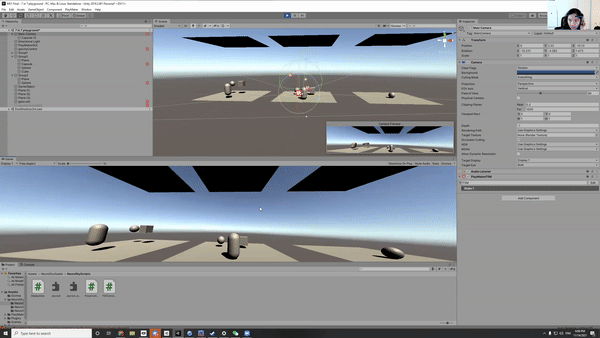Braindance
Experimental interactive experience with BCI
MFA Design and Technology Thesis
Unity, Open Sound Control, Emotive EEG
Featured in the BFA/MFA Thesis Show
Braindance
Experimental interactive experience with BCI
MFA Design and Technology Thesis
Unity, Open Sound Control, Emotive EEG
Featured in the BFA/MFA Thesis Show
Braindance is an interactive play experience through a forest while the environment changes in response to the player’s change of state of mind. This project explores a new way to design experiences that utilizes the unique characteristics of Brain Computer Interface(BCI) and avoids some current limits of this technology such as high latency and low feedback. The purpose of this project is to propose the possibility of using brainwave data as an involuntary input, and discuss this approach as the possible solution to some of these major deficits of integrating Brain Computer Interface(BCI) into games and other interactive experiences.
The Full thesis paper is available HERE.
State: high relaxation
Design Process
The main question, and the foundation of this project is about the application of BCI in interactive experiences. What are the special advantages and disadvantages of this technology?As designers, how can we best utilize the characteristics of this technology to create unique interactions? Specifically, how to change the environment based on the player’s mind to create interactions unique to this technology without directing disproportionate attention from the player outside of the environment?
Prototyping
The project initially started as a continuation of this project, where I explored the possibility of basic interactions available with BCI in a game, other than simply taking a motor input and replacing that with “willpower”. The initial part was all about defining “states” of mental relaxation - to select channels available from the headset, and interpret data pass from the EEG as those states. The figure on the left shows an early prototype of manipulating objects in the scene with a combination of gaze and brainwave data.
Communication Pipeline
The communication pipeline has three layers: an portable EEG headset(the Emotiv Insight 2) as the data collection device, Processing as the data cleaning and communication middleware, and Unity Engine as the visualization layer for the virtual scene to be constructed and for players to see their brainwave data visualized in the form of VFXs in the virtual environment. Communication between the headset and processing is through Open Sound Control protocol, and from processing to Unity through Serial Communication.
Level Design
Through feedback from user testing and critique sections, I chose to mainly manipulate the volumetric fog level and lighting of the scene. As lighting and fog level change, the overall aesthetics of the scene changes drastically, thus creating a contrast that allows the user to clearly understand the difference between their two mental states. The volumetric fog effect applied can also select and reflect certain spectrums of colors, making it possible to change the color tone of the environment as the player ventures to different regions of the map in this experience.
In the realm of video game design, making the conscious decision to utilize visually striking points of interest as a means of guiding players through a virtual world can be particularly effective, especially in the absence of an explicit narrative. Since Braindance is an experience about navigating the space at the player’s own pace, there will be no explicit narrative or guidance that tells the player where to go next. My solution to the potential problem of players not knowing where to go next is the integration of three monumental artifacts, strategically positioned within the game's landscape, to act as both beacons and goals for players to explore.
These awe-inspiring structures not only serve as markers for navigation, but also pique the players' curiosity and instill a sense of wonder, motivating them to venture further into the unknown. By incorporating such distinct visual elements, I hope to create a more immersive and engaging experience for players, fostering a natural and intuitive sense of progression throughout the game world. This approach allows players to forge their own path and establish a personal connection with the game's environment, ensuring a memorable and satisfying gaming experience.









